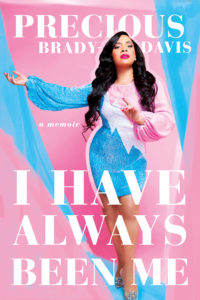
I KNEW from the age of six that I was not like other kids—in so many ways. I was biracial, walked with a swish, and emulated many of the actions and gestures of the women in my family. In fact, I engaged in brazen acts of femininity throughout my childhood.
I was just starting kindergarten, and it was around this time that I started dressing up and playing house, and an awareness of my gender was starting to emerge. I would wrap a blanket around my waist and turban-tie a bath towel onto my head and glide down the halls as if wearing a floor-length gown. Inspired by the likes of Jem and the Holograms, Carmen Sandiego, and Storm from X-Men, I was in my element.
My Grandmother hoped the outdoors and dirt would stop me from being dainty. She locked me outside to play, but that didn’t work: The tall trees of the ravine were my proscenium, and the neighbors’ uninhabited backyards served as my audience. I continued to sing. Many an afternoon was spent prancing across the picnic tables in our backyard as I hollered Whitney Houston’s “I Will Always Love You” as loud as I could. Growing up in the early 1990s provided no end of divas to emulate: Tina Turner, Bette Midler, Paula Abdul, Madonna, Janet Jackson, and Mariah Carey. I triumphantly showed up, proudly defining a space around me long before I knew the political might of such a stance.
Even so, church remained the one constant that I never questioned. On Sundays I relished walking up the tiled staircase of Victory Church into big hugs from glamorous greeters who stood in the foyer. The woman I most identified with and looked up to at church was named Nina. I idolized her and probably hoped subconsciously that I would grow up to be her. In the summer before I entered third grade, she took me shopping with her to find a pair of shoes that would match her off-white wedding dress. She ended up finding a pair at Payless that she liked, but we had to leave them behind to be dyed the exact ivory color she needed (in the ’90s, dye-able shoes were all the rage). Her wedding colors were ivory and navy blue, Air Force colors in honor of her fiancé, Marshall. When the shoes were ready and we brought them back home, I couldn’t wait until Nina left the house so I could sneak into her room and try them on. To me, those heels were simply irresistible. She had such bad taste in shoes, and when I say “bad,” I mean it in the sense of mesmerizing!
As soon as she left to go hang out with her friends, I raced into her room to find the box and try on those gorgeous custom wedding pumps! I nervously glanced toward her large collection of wide-eyed stuffed animals piled in a hanging net, the only witnesses to my crime. But nothing could stop my mission, and soon I was strutting up and down the halls, tripping on our matted green carpet, clomping because the shoes didn’t even come close to fitting, but feeling so right and so fabulous. Nina eventually came home and of course noticed immediately that the box wasn’t how she’d left it. She was livid, and there was no denying that I was the culprit, because my tiny feet had bent the corners of the shoes very noticeably. I’m lucky I was still the ring bearer in her wedding.
In my defense, I didn’t feel like I had a choice when it came to this kind of behavior, more often than not involving women’s shoes, and almost always getting me into a lot of trouble. One memorable day I risked my experimentation outside the safety of our home, and “accidentally” wore Tanisha’s Mootsies Tootsies to school. These were a popular kind of loafer for girls at the time, unmistakably not a boy’s shoe. When confronted by my classmates for the ill-fitting and feminine shoes, I gave the performance of a lifetime, looking down at my feet with utter shock and embarrassment at this horrible mistake I’d made in my morning rush!
Looking back, I wonder whether wearing those shoes was only an act of feminine desperation, or did a part of me want to get caught and questioned? Maybe subconsciously I hoped that if I let these urges play out, someone would be able to tell me what they meant.
Despite my religious upbringing and unstable childhood, I was able to find my truth and become comfortable in my own skin. If someone had told me that one day I’d settle into blissful family life at the age of thirty, that I would meet my soulmate and have a child calling me Mom all day, I would have theatrically laughed in their face. Getting here was hard, but I never for one second let anyone tell me that my circumstances would stop me from finding happiness and stability in this life.

Precious Brady-Davis is an award-winning diversity advocate, communications professional, and public speaker. She currently serves as the associate regional communications director at the Sierra Club. Precious is married to Myles Brady and lives in Hyde Park on the South Side of Chicago, where they are raising their daughter, Zayn. I Have Always Been Me is her first book.






